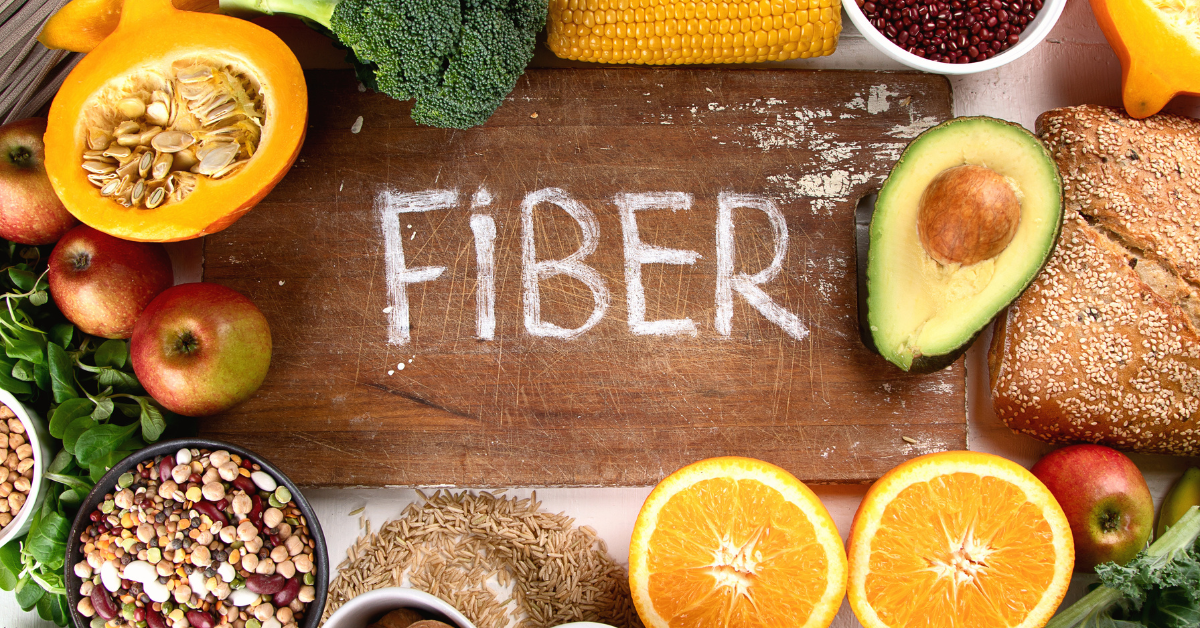Fiber is important for digestive and heart health and so much more. Increasing fiber intake can lower the risk of diseases including heart disease, diabetes, diverticular disease, constipation and colon cancer, increases satiety and promotes overall health. Research shows almost 94% of Americans aren’t getting enough fiber every day.
What Is Fiber?
Dietary fiber is material from plant cells that cannot be broken down by enzymes in the human digestive
tract. There are two important types of fiber: water-soluble and water-insoluble.
- Soluble fiber absorbs water during digestion. Increasing fiber intake can help lower cholesterol and regulate blood sugar levels. Soluble fiber can be found in fruits (such as apples, oranges and grapefruit), vegetables, legumes (such as dry beans, lentils and peas), barley, oats and oat bran.
- Insoluble fiber remain unchanged during digestion. They promote normal movement of intestinal contents, preventing constipation. Insoluble fiber can be found in fruits with edible peel or seeds, vegetables, whole grain products (such as whole-wheat bread, pasta and crackers), bulgur wheat, stone ground corn meal, cereals, bran, rolled oats, buckwheat and brown rice.
How Much Fiber Do I Need?
The Dietary Guidelines for Americans state that women older than 14 years should get at least 25 to 28 grams of fiber in a day, while men should aim for 31 to 34. A more general, reliable target is 25 to 30 grams of fiber per day.
According to the DGA, more than 90% of women and 97% of men are not getting enough fiber into their diet. The average American only consumes between 10 to 15 grams of fiber in a day. So what does it take to get more fiber into your diet?
How Do I Increase Fiber In My Diet?
The easiest solution to increasing fiber intake is to swap out habitual foods you eat with high-fiber foods. For example, if you have a sandwich for lunch, look for whole-grain bread that has higher fiber content, between three to five grams per slice. If each slice of your sandwich has five grams of fiber, that’s 10 grams already! Other whole-grain swaps to consider include pasta, tortillas, brown rice, and crackers.
Another easy way to meet your fiber needs is by adding high-fiber foods to the meals you’re already eating. For example, if you start the day with Greek yogurt, add in some raspberries (eight grams of fiber per cup), chia seeds (five grams per tablespoon), and almonds (three grams per one ounce). Oatmeal is a great high- fiber breakfast (four grams per one cup cooked), as well as avocado (five grams per half-avocado). Smash the avocado onto whole grain toast, and you’re almost half way to your daily fiber needs.
Increase fiber at lunch and dinner by making at least half your plate vegetables. Start the meal off with a side salad topped with ½ cup garbanzo beans or black beans (7 grams fiber).
If you prefer starch on the side, high-fiber starches are some of the best sources of this particular nutrient. One cup of black beans contains 15 grams of fiber, while potatoes (both white and sweet) contain four grams.
Tips to Increasing Fiber
It’s important to note that you should always drink an adequate amount of water with your fiber intake to
help with the process of digesting fiber. A rule of thumb is to drink one liter (just over four cups) of water with every 10 grams of fiber you consume.
Water is also essential for avoiding uncomfortable gas or bloating during the digestion process, which can happen if you consume too much fiber at once. If your body isn’t used to taking in that much fiber, you will likely experience intestinal gas, abdominal bloating, and cramping. Instead, be sure to increase your fiber gradually over a few weeks, as if you’re training your digestive tract to adjust. If you’re currently getting 10 grams of fiber per day, increase by 3-5 grams a day every few days until you get to your recommended fiber needs.
Signs That You’re Not Getting Enough Fiber
While the average American only gets around 10-15 grams of fiber a day, some may even be getting less,
which can cause a series of health issues. Some of those signs of a low-fiber diet include:
- High cholesterol
- Constipation
- Weight gain
- Feeling hungry
- High blood sugar
- Digestive pain
Should I Take a Fiber Supplement?
Along with getting more fiber from dietary sources, some might find it helpful to also add a fiber
supplement into their routine. Talk with your doctor to understand if this is right for you. One of the most
popular forms of supplemental fiber is psyllium husk, a natural form of soluble fiber. Psyllium husk can help lower cholesterol, relieve constipation and diarrhea, and treat other intestinal problems like irritable bowel syndrome and hemorrhoids.
Featured Recipes:
Homemade Black Bean Burgers
Confetti Salad with Lime-Cilantro Dressing

